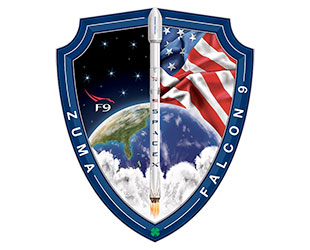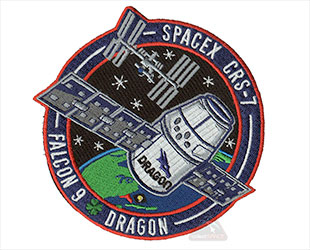Jan. 12, 2018 — SpaceX has recalled the sale of souvenir mission patches from its first launch of 2018, providing a possible hint to the fate of its classified payload.
The spaceflight company pulled its Zuma mission patches from partner gift shops and online retailers on Friday (Jan. 12), several days after the embroidered emblems went on sale. Since 2015, SpaceX has allowed for third-party sales of its mission patches so long as the flight that the insignia represents was confirmed a success.
SpaceX recalled the sale of the Zuma mission patches in "consideration for their customer," a seller who goes by the handle "usafspace" on eBay posted Friday evening on the collectSPACE forums and on Reddit's SpaceX subsection.
The patches were also noted as missing from the pegs at the souvenir shop for the U.S. Air Force Space and Missile Museum Sands Space History Center in Cape Canaveral, Florida, where they had been available for $7 each earlier in the week.

Mission patch artwork for SpaceX's launch of the Zuma classified payload on a Falcon 9 rocket on Jan. 7, 2018. (SpaceX) |
A SpaceX Falcon 9 rocket lifted off from Launch Complex 40 (SLC-40) at the Cape Canaveral Air Force Station at 8 p.m. EST on Sunday (Jan. 7; 0100 GMT Jan. 8). The flight appeared from the ground to proceed as planned, with the rocket's first stage returning to a landing at the Cape, while the second stage proceeded with the classified payload on a path to low Earth orbit.
At the request of its customer — which is only known to be the U.S. government; no agency has claimed ownership of the "restricted payload" — SpaceX ceased status updates on Zuma's climb to orbit after separation of the first stage.
The next morning, however, reports began circulating that the Zuma payload had either been stranded in orbit or had fallen back to the Earth, dropping into the Indian or Pacific oceans. Some media, citing unnamed sources, suggested that Zuma had failed to separate from its payload adapter, a mount between Zuma and the Falcon 9 upper stage, that was provided by the U.S. government's contractor for the mission, Northrop Grumman.
Responding to the press and still limited by the clandestine nature of the mission, SpaceX president Gwynne Shotwell issued a statement that "after review of all data to date, the Falcon 9 did everything correctly on Sunday night."
"If we or others find otherwise based on further review, we will report it immediately," Shotwell said, noting in addition that SpaceX's upcoming launch schedule was unaffected.
SpaceX appeared to treat the launch as it has its previous successful missions, releasing launch imagery online and providing its retail partners with mission patches for sale.
By Friday night, almost 50 of the patches had been sold on eBay before the recall went into effect.

SpaceX withheld distributing its Dragon CRS-7 mission patches in 2015 after suffering its first Falcon 9 launch failure. (collectSPACE) |
SpaceX's policy with regards to its mission patches dates back to June 2015 and the company's first Falcon 9 launch failure. Following an in-flight explosion that led to the loss of a NASA-contracted, uncrewed Dragon cargo ship bound for the International Space Station, SpaceX held back the distribution of its CRS-7 patches and began with its next flight waiting until after the missions were complete before beginning third-party sales.
SpaceX also began holding back its insignia artwork until a day before the scheduled launch — a decision that meant no mission patch was ever seen for the 2016 launch of the Israeli Earth communications satellite Amos-6, which was destroyed in a pre-flight engine test.
The now-recalled Zuma patch depicted a SpaceX Falcon 9 rocket launch set against Earth as seen from space and an American flag. The shield-shaped emblem included a four-leaf clover at the base of its border, a "good luck" staple on all of SpaceX's mission patches since the company's first successful launch in 2008.
